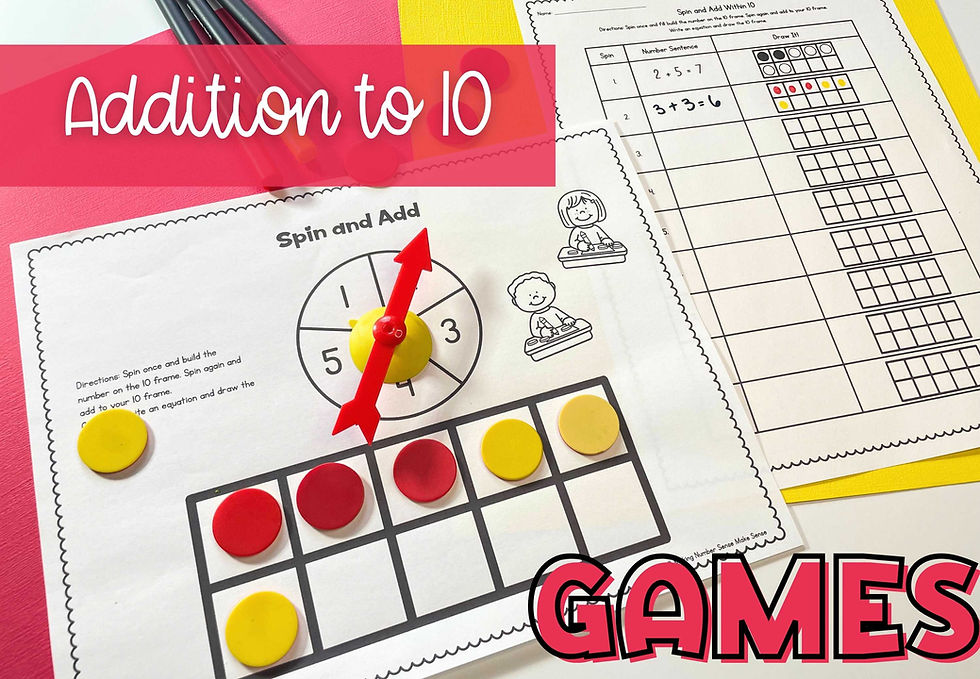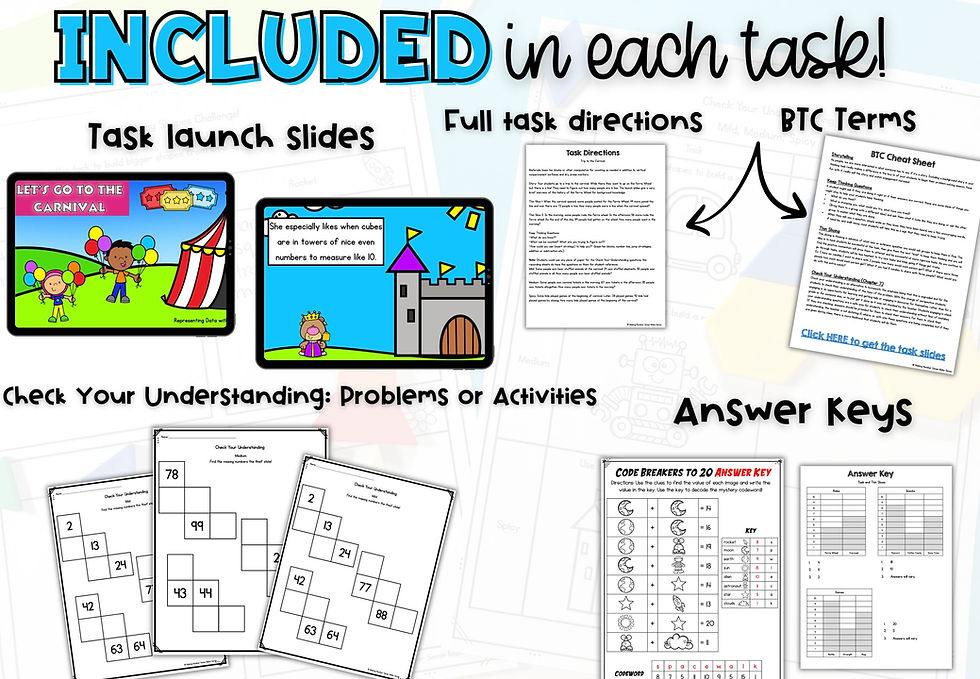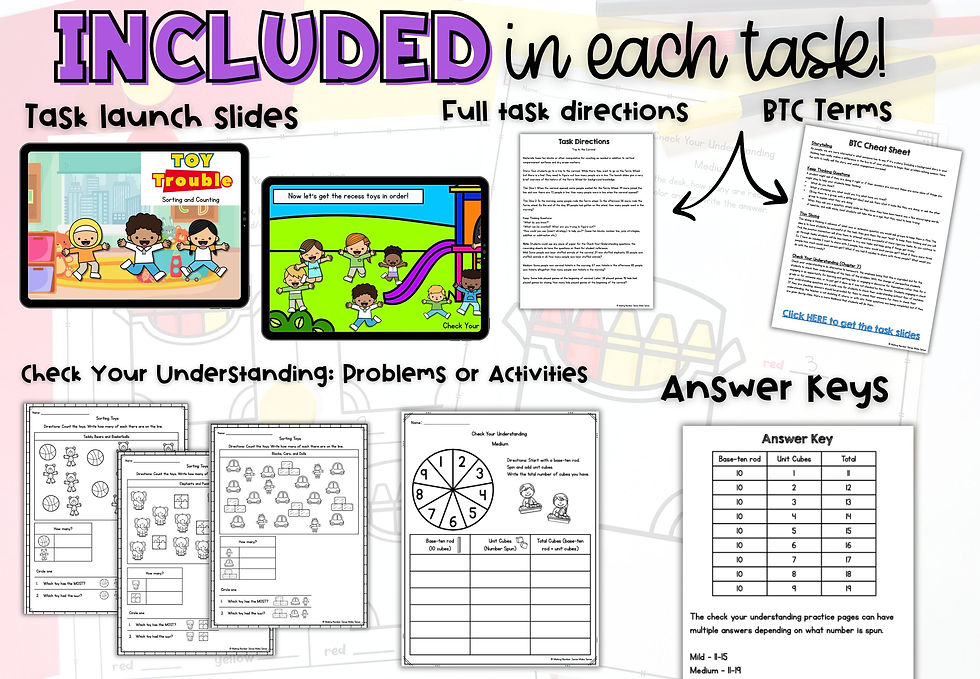Addition Within 10 and 12 Games for Kindergarten and First Grade
- Lara

- Apr 20, 2024
- 4 min read
This is the time of year when kids have hopefully developed some independence in terms of your math centers and also around the time of year when we need to do lots of assessments and in the younger grades it's usually one-on-one.
Here are five simple printable addition games that students can play independently and with a partner.
These games have some variety in terms of the manipulatives you're using, but simple to use and things that you probably already have in your classroom.
You're going to need some dice, spinners, and some type of counter.
I will have the ones that I enjoy linked and I have to say spinners I use them all the time. It can increase engagement because kids love spinning those and they make differentiation easy! When you make a spinner, or even just print it and handwrite it, you can choose whatever number range you want.
These addition games are pretty simple and don't include a lot of varied directions, playing these games frees you up to circulate the room if you need to or pull students one one-on-one or in a small group because they're engaged in these fast-paced games that are accessible to them and easy to differentiate.
Spin and Add
To play Spin and Add your students will spin once and then they can put their first spin on a 10-frame, and then spin again to get their second spin, and then put those on the 10-frame,
they add the two spins together to find the sum. This game has an optional recording sheet that students can use with it so they can practice writing equations along with the addition within 10.
Roll A Two-Color Tower
The next game is using cubes and dice. It's called Roll A Two-Color Tower So for this game your students would roll one die and then make a tower that matches and then roll a second one and make a tower that matches that and put them together find the sum. This a game comes with a play mat that they can either put their towers on the matching sum, or color in the matching sum.
If they make towers for all of them, you may need a lot of cubes!
A tip this game would be to sort the different colors before your students play that game so that they're not spending time picking out the colors they want and can just grab the colors that are already sorted.
If you don't want to sort them yourself, you can have a student at the end of the day or a student who comes in early help you sort the colors.
Ladybug Addition
The next game is called Ladybug Addition. To play, your students would roll one die and then put that many counters on one side of the ladybug, roll again, put that many on the other side of the ladybug, and count them all together to get their sum. Similar to Spin and Add, there is an optional recording sheet so that they can keep track of what they're spinning and write equations to match.
As you're circulating, you can see if students having any trouble writing equations, if they're having trouble writing numbers, or anything like that. Or if they're getting it and may be ready to do more than one die for each roll. That's something that you'll be able to see too on the recording sheet.
Add Them Up!
The next two games are partner games. One of them is called Add Them Up. What your students will do is roll two dice and then figure out what the sum is, and then cover that number on the play mat. Then the other student would roll two dice. Figure out the sum, and cover up that one on the playmat. If there is no more of their sum available, they lose their turn.
They can keep track using two different counters or two different colors if you are using this game as a printable addition game. At the end, they can count to see who has more squares colored or covered.
Working with partner games are a great way to build fluency and cooperative learning support. There's no writing involved in this game so fluency can be the focus and faster than some of the other games. Another benefit of partner games is that students can correct each other, kindly. You can offer strategies for them to support their partner and talk to them about if they notice that their partner maybe didn't count correctly, or they missed a number, they can prompt them to count again or offer their fingers to help their partner count and help get better and develop more fluency and automaticity with numbers up to 12.
Sevens
This last game is called Sevens. And the goal of this game is to roll a seven. So your students would roll your two dice, write down their equation, and determine their sum, to win this game, one partner needs to be the first one to roll five sevens.
I chose seven because there are lots of combinations that make seven with two dice, but you can have it be any number.
You can adjust that game to look for 6s or 8s, 9s or 10s depending on what your students are working on so they can learn math facts to 7, math facts to 8, math facts to 9, 10, etc.
If you want to differentiate it down, they sell those little circle stickers that you can put over the pips on dice and then just write the number that you want the kids to be working on So maybe they have a traditional dice and a one, two, and three dice, so they have two ones, two twos, two threes, and then that way it makes the range smaller if they need it.
The independent games are Spin and Add, Ladybug Addition, and Roll a Two Color Tower, and the partner games are Add Them Up and Sevens. These games are flexible and easy to use. You don't need a lot of materials and your kids are getting number writing practice, equation practice, independent and partner work practice.
If you are looking for addition and subtracting games, you can get them here!








Comments